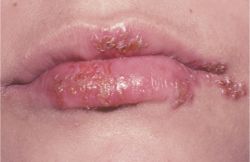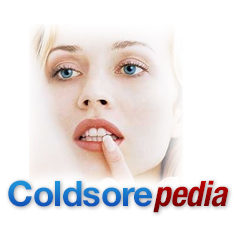 The name “fever blister” would suggest something associated with a fever, perhaps a symptom of a disease occurring alongside fever. The other common name for this affliction, “cold sores,” would suggest a side effect of the common cold. Neither of these is accurate.
The name “fever blister” would suggest something associated with a fever, perhaps a symptom of a disease occurring alongside fever. The other common name for this affliction, “cold sores,” would suggest a side effect of the common cold. Neither of these is accurate.
A fever blister is caused by the herpes simplex virus type 1 (HSV-
Symptoms
The primary symptom of HSV-
the virus becomes dormant in the nerves of the face, causing no symptoms. It can erupt into new symptoms (usually milder than the first outbreak) at any time. Often recurring symptoms are associated with increased stress or a weakened immune system. This is the source of the name “fever blisters” or “cold sores,” as infection with a different virus such as a cold or flu is a sign of a weakened immune system (or
may temporarily cause a weakened immune system), and this can allow the herpes virus to strike again. The herpes virus is completely distinct from either the rhinovirus (which causes the common cold) or flu viruses, however.
When an outbreak first begins, the victim often experiences a tingling or burning sensation in the lips. This is the first symptom that an outbreak is occurring, and it is easy to miss. It is usually followed by the eruption of blisters, most commonly on the edge of the lip, within
one to two days. After a day or so the blisters burst and are covered over with a scab-
Complications
For most people, fever blisters aren’t dangerous, merely annoying. In cases where the immune system is seriously compromised, however, they can present more serious complications. It may also be a good idea to take steps to prevent infecting others. These include avoiding kissing someone while an outbreak is active, and practicing good general hygiene. However, as most people are infected with the virus by about age ten, all of this may be moot except where small children may be exposed.
Similar symptoms, also caused by a herpes virus infection, can appear in other parts of the body. These include the eyes, the fingers, and the genital area. Genital herpes lesions are more often caused by the type 2 herpes simplex virus (HSV-
An active herpes outbreak, regardless of the type of herpes, is considered dangerous for a baby when it occurs during childbirth. This is particularly true when lesions are found inside the vagina. The danger lies in infecting the infant with the herpes virus, which can cause serious complications in a newborn including blindness and brain damage. When an active herpes lesion is found at delivery, a caesarian section is indicated. The virus is not considered dangerous to the baby when in its dormant state, however.
If cold sores persist for longer than a week, spread to a second location, make talking or swallowing difficult, or are accompanied by fever other than in the first outbreak, these are signs of potential complications and you should see a physician.
Treatment Of Fever Blisters
There are no treatments known to cure fever blisters or get rid of the herpes virus. Some antiviral medications can speed up recovery from an outbreak. These include acyclovir (Zovirax), valacyclovir (Valtrex), and famcyclovir (Famvir). However, they need to be taken starting when the first symptoms of the outbreak appear. By the time visible blisters occur it’s too late for them to do much good.
Fever blister symptoms normally go away in about a week. If an outbreak is uncomfortable, general pain-
The bottom line with fever blisters is that they won’t kill you, but you won’t kill them, either. Some people carry the herpes virus all their lives and experience no further outbreaks of symptoms after the first ones. For others, it’s a recurring illness that is never very bad but never goes
away for good.
